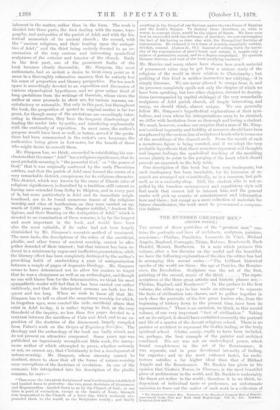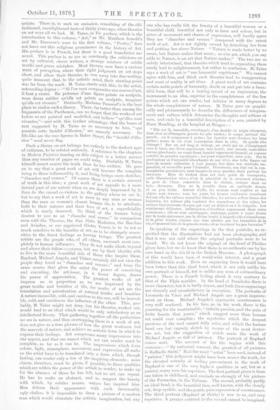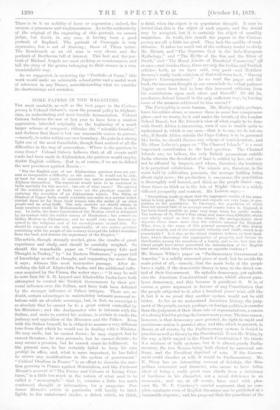THE HUNDRED GREATEST MEN.* [SECOND NOTICE.]
THE second of these portfolios of the " greatest men" con- tains the portraits and lives of architects, sculptors, painters, musicians,—Phidias, Praxiteles, Leonardo da Vinci, Michael Angelo, Raphael, Correggio, Titian, Rubens, Rembrandt, Bach Handel, Mozart, Beethoven. In a note which prefaces this volume, after a few theories on the useful and the beautiful, we have the following explanation of the idea the editor has had in arranging this second series :—" The brilliant historical epochs of the world are three : the age of Pericles, the Renaiss- ance, the Revolution. Sculpture was the art of the first, painting of the second, music of the third The repre- sentatives of the three great artistic and historic phases are,— Phidias, Raphael, and Beethoven." In the preface to the first volume, the editor says he has made an attempt " to separate the facts of civilisation into classes, and to gather together in each class the portraits of the few great leaders who, from the beginning of history down to the present time, have been its representatives." There is an omission, we think, in this second volume, of one very important " fact of civilisation." Taking art as its subject, it should have contained assuredly the portrait and life Of a master of the devout religious school. There is no painter or architect to represent the Gothic feeling, or the truly spiritual school. Giotto, surely, ought to have been included, as, perhaps, the best example of the painter and architect combined. His art was not an undeveloped power, which found completeness in the art of the Renaissance ; it was separate, and in pure devotional intensity of feeling, far superior ; and to the most cultured tastes, his archi- tecture satisfies a far higher ideal than that of Michael Angelo and the Renaissance. Mr. Ruskin has given as his opinion that Giotto's Tower, in Florence, is the most beautiful piece of architecture in the world, and Mr. Ruskin is undeniably the finest art-writer in the world ; therefore it is, we think, in- dependent of individual taste or preference, an unfortunate omission to leave out the maker of Buell work in a collection of .1' The Hundred °rented Men. Portraits of the Hundred Greatest Men of History, reproduced from Fine and Hare Steel Engravings. Vol. G., Art. London: Semption Low and Co. • artists. There is, in such an omission, something of the old- fashioned, unenlightened taste of thirty years ago, when theories on art were all we had. M. Taine, in his preface, which is the introduction to this volume, "Art," as Mr. Matthew Arnold's and Mr. Emerson's wore to the first volume, " Poetry," does not leave out this religious prominence in the history of Art. His preface is in French, but there is a good translation an- nexed. This preface is, as are so constantly the criticisms on art by cultured, clover writers, a strange mixture of, subtle truths and grave mistakes. Most literary men have a curious want of perception, where their right judgment on art stops short, and allow their theories to run away into fine-writing, quite innocent that, to the artistic mind, their starting-point was far from the mark. M. Taine starts with this, to the artist, astounding dogma :—" Si l'on vent comprondre une oeuvre d'art, it faut y croire. En pr6sence d'une figure pointe ou sculpt6e, yowl devez oublier Volk est peinte on sculpt6e, imaginer qu'elle est vivante." Distinctly, Madame Tossaud's is the best place to realise such a theory. There, far better than among the fragments of the Parthenon, can we forget that the works of art before us are painted and modelled, and believe "qu'elles soot 'ivantes,"—and with this further advantage, that the hours of rest suggested by M. Tabus as so necessary to him, "qui possede cette facult6 d'illusion," are scarcely necessary. So life-like are the wax figures in Baker Street, the "facult6 d'illu- sion " need never flag.
Such a theory on art belongs too entirely to the darkest ages of criticism, to be refuted seriously. A reference to the chapters in Modern Pointers bearing on this subject is a better answer than any number of pages we could write. Probably M. Taine himself meant nearer the truth than he has written. Ho goes on to say that a great work of art will become the complete being to those influenced by it, and living beings mere sketches, ." 6bauches mid venues." Of course there is a certain amount of truth in this idea; a great work of art appeals to a more inward part of our nature when we are deeply impressed by it, than do the casual co-visitors to the gallery where we see it ; but to say that a work of art is more to any man or woman than the man or woman's closest hurnat,is to attribute, both to their natures and their love of art, a superficiality which is rarely deserved. To think of the human being dearest to you as an " Annelle mal venue," in comparison even with the Theseus, the San Sisto Madonna, the Bacchus and Ariadne, or our aggrieved Giotto Tower, is to be not so much sensitive to the beauties of art, as to be strangely unsen- sitive to the finest feelings as human beings. The greatest artists are the people who, of all others, succumb most com- pletely to human influences, They do not make ideals beyond and above their fellow-creatures, but are by their ideality able to live in the more beautiful side of those who inspire them. Raphael, Michael Angelo, and Titian certainly did not view the people they loved as " 6bauches mal venues ;" and from the same source that gives the artist the power of conceiving and executiug, the art-lover, in a lesser degree, draws his power of appreciation. The greatest works of art impress us in proportion as we are impressed by the great truths and beauties of life, for works of art are the translation and accentuation of natural truths and beauties- A nature insensible, cold, and careless to the one, will be insensi- ble, cold, and careless to the influence of the other. This, pro- bably, M, Taine might not deny, but his theories, worked out, would lead to an ideal which would be only satisfactory as an intellectual theory. That gathering together all the perfections we see in nature, and then overtopping them in a work of art, does not give us a true picture of how the great workmen feel the marvels of nature, and achieve an artistic form in which to express their feelings. Art compresses many impressions into one aspect, and that one aspect which art can render must be complete, as far as it can be. The impressions which form colour, light, atmosphere, movement, and expression all make on the artist have to be translated into a form which, though lasting, can render only a few of the inspiring elements ; more charm, therefore, must be given, if possible, to those qualities which are within the power of the artisit to render, to make up for the absence of those ho has felt, but no art can repeat. He has to make an abstract, and to suggest the beauty with which, by subtler means, nature has inspired him. Men deform their appearance with such inexcusably ugly clothes, it is impossible to draw a picture of a modern man which would stimulate the artistic imagination, but any
one who has really felt the beauty of a beautiful woman or a beautiful child, beautiful not only in form and colour, but in grace of movement and charm of expression, will hardly agree they are " 6bauches mal venues " compared with the rarest work of art. Art is not rightly served by detaching her from and putting her above Nature. "Nature is made better by no mean, but Nature makes that mean ; so o'er art, which you say adds to Nature, is an art that Nature makes." The two are so subtly intertwined, that theories which tend to separating them rarely lead to enlightenment, but rather to confusion. M. Taine says a work of art is "une humanity sup6rieure." We cannot agree with him, and think such theories lead to exaggeration and want of reality in art ideas. A great work of art contains certain noble points of humanity, dwelt on and put into a beau- tiful form, that will be a lasting record of an impression, the monument to an idea, superior in the completeness of the few points which art can render, but inferior in many degrees to the whole completeness of nature. M. Taine goes on graphi- cally and picturesquely to describe the differences of tempera- ment and- culture which determine the thoughts and actions of men, and ends by a beautiful description of a nun, painted by Hans Memling, at the hospital at Bruges :-
" Elle est lh, immobile, envoloppee d'un double et triple vetetnent, dont rico ne derangera jamais les phis raides ; in corps attenne dig- paratt,---on to soupconne it peine ; les epaules soot dtroites, les bras greles ; touto la vio s'est concentree dans la tete. Et (mule tote etrange ! Sur un col long of delicat, un oval° qui va s'elargissant vera le hunt, one levro supericure trhs haute, one arcade sourciliere encore plus haute, on vasto front boodle vaguemont bosseki, et comme comble de ponsees mystiques ; les yenx regardent, sans voir. Par in profondeur ot l'intonsite absorbent° de son rev°, une tello figure est hors du monde ordinaire, t tout jamais fixe dans son attitude, im- passible, et, recueillio pour l'eternite. Desormais, son etat est la con- templation persistent°, sans images et sans paroles, dont parlent les docteurs. Rion do violent dans cet eta, point do transports, null() illumination vivo ; c'est In placidito de in croyanco absolue, la paix do lame conserve° dans le cloitre, comme dans on beis,—dormant. Rien no in trouble dans se quietude deuce, . et on pen triste. Autour (Tolle, lea actions sont reglees et les objets soot terries ; tons les jours, les heures uniformes ramdneut devant elle les memos =waffles blanches, les memos refiets bruns des boiseries, les memos phis tombant des capueloms et des robes, les memos broissements des pas qui vont an dertoir on it 1a chopollo. Les sentiments delicates, indistinetes, s'eveillent vaguement dans cotte monotonic ; elle so sent enveloppee, soutenue, porter it toute heure par la toute-puissance, par la divine bonte, iit laquelle elle s'abandonno, et in pike tendre, comme une rose abritee par les brutalites de In vie, s'epanouit loin de la grando route, oh se heurtont les pas humains."
In speaking of the engravings in the first portfolio, we re- gretted that the illustrations had not been photographs, and that it was not said where the original portraits were to be found. We do not know the original of the head of Phidias given here, but we do know that there is an authentic one by his own hand on the shield in the British Museum. A photograph of this would have been of world-wide interest, and a great addition to this work. Even an engraving from it would have been better than this ideal head, which is not only unlike his own portrait of himself, but is unlike any man of extraordinary power. There is a French feeling about it very contrary to that of the Elgin marbles. In the head of Praxiteles there is more character, but it is badly drawn, and both these engravings are slovenly and unsatisfactory in execution. The portraits of Leonardo da Vinci and Michael Angelo are a great improve- ment on them. Michael Angelo's expressive countenance is very well rendered. In his face, as iu his work, there is the yearning for the unattainable, "infinite passion, and the pain of finite hearts that yearn," which suggest more than human art Could ever complete ; the mysteries which the deepest passions of the soul cannot fully seize, and which the human hand can but vaguely sketch by means of the most dexter- ous art, but the suggestion of which made the work of Michael Angelo so full of interest. The portrait of Raphael comes next. The account of his life begins with this sentence :—" By universal consent, the greatest of all painters is Raffaello Santi." Had the word " artist" been used, instead of "painter," this judgment might have been nearer the truth, for the elevated serenity of feeling pre-eminent in the work of Raphael is one of the very highest qualities in art; but as a painter, many were his superiors. The first portrait given is from one taken in childhood, and reminds us strongly of his picture of the Fornarina, in the Tribune. The second, probably partly an ideal head, is the beautiful face, well known, with the clearly cut, deep eyelids, and the gentle, pure expression of countenance. The third portrait (Raphael at thirty) is new to us, and very repulsive. A greater contrast to the second cannot be imagined.
There is iu it no nobility of form or expression ; indeed, the reverse, a grossness and unpleasantness. As to the authenticity of the original of the engraving of this portrait,' we cannot judge, but doubt, in any case, it having been a good portrait of Raphael. The portrait of Correggio is very expressive, but is out of drawing ; those of Titian better. The Rembrandt as an old man is very clever, and the portrait of Beethoven full of interest. This last and the por- trait of Michael Angelo are most striking as countenances, and tell the story of the genius belonging to their owners in a very unmistakable way.
As we suggested, in reviewing the " Portfolio of Poets," this work would make an admirable school-prize and a useful work of reference iu any library, notwithstanding what we consider its shortcomings and mistakes.


































 Previous page
Previous page